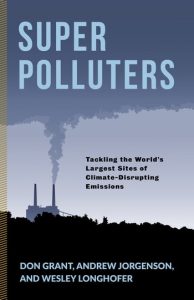In Super Polluters: Tackling the World’s Largest Sites of Climate-Disrupting Emissions, Don Grant, Andrew Jorgenson and Wesley Longhofer analyse the impact of power plants on climate change, demonstrating the disproportionate role that a small number of major plants play in a nation’s overall CO2 emissions. The book is a valuable read for scholars, students and policymakers interested in discussing climate change, development and activism, finds Nikhil Deb.
Super Polluters: Tackling the World’s Largest Sites of Climate-Disrupting Emissions. Don Grant, Andrew Jorgenson and Wesley Longhofer. Columbia University Press. 2020.
 Find this book (affiliate link):
Find this book (affiliate link): ![]()
In Super Polluters, Don Grant, Andrew Jorgenson and Wesley Longhofer analyse the impact of power plants on climate change. On the one hand, the electricity produced by power plants is deemed vital to social and economic activity around the globe. On the other, they emit more CO2 than any other industrial sector (Dan Tong et al, 2018). Specifically, the world witnessed a 60 per cent increase in power plants’ contribution to carbon emissions over the last two decades, and the Intergovernmental Panel on Climate Change suggested that this could double by 2050 if no change is made (Chapter Two). Super Polluters attempts to mediate many debates, such as those on energy efficiency, and looks at data from both the United States and the global stage to determine which route is best for the world’s many diverse economies and ecosystems.
Each chapter of the book is broadly organised into subsections: an introduction, background, theory, analysis and conclusion. Readers are given ample figures, statistics and other forms of data to help us understand the book’s overall argument. Additionally, the authors offer insight not only into the statistics of carbon emissions, but also the culture surrounding how emissions get created and regulated. Most analyses of CO2 emissions, as the authors note, pin down the problem to the sector level, overlooking how ‘the same actors that pollute at high levels tend to pollute at higher rates’ (79). For example, in Chapter Two, ‘Cleaning Up their Acts’, the authors analyse the role high-productivity plants play in a nation’s overall CO2 emissions, using and applying William Freudenburg’s sociological research on disproportionality.
For Freudenburg, the party responsible for the lion’s share of toxic emissions is a small subset of a sector’s facilities. Similarly, the authors of Super Polluters demonstrate that it isn’t the entire production industry causing the problem in some nations, but a handful of major plants that emit larger amounts of pollution than others. The authors use regression analysis to examine the rates of CO2 emissions among the ten most emission-heavy nations worldwide and the inequalities in these emission rates.
They analyse the base CO2 emission rate for these ten countries, the three highest being China, the US and India. They not only document the percentage of nationwide emissions for each of these ten countries from plants that are in the top 5 per cent of productivity, but they also analyse how national emission rates for each of the ten countries would be affected if these plants were to reduce their emissions down to the average. The findings show that eight of the ten countries analysed would experience a prominent decrease in emission levels if these reductions were to occur. All nations examined showed a higher level of disproportionality in emissions, indicating that this could correlate with the large percentage of emissions these nations produce. In sum, the results make it clear that emission disproportionality can have a heavy impact on nationwide emission levels.

Photo by Simone Hutsch on Unsplash
In Chapter Four, ‘A Win-Win Solution?’, the authors explore energy efficiency and its relation to global carbon emissions. This chapter highlights an essential paradox: as power plants find more effective and eco-friendly ways to produce energy, they often increase their output in response to their elevated efficiency. In doing so, they also produce more CO2 than they would otherwise, an effect the authors call ‘backfiring’ or the ‘rebound effect’. First, the authors explore all realms of the arguments, some optimistic and others pessimistic, and make way for readers to form their own assumptions before being faced with complex data. While their estimations of backfiring proved to be accurate — as larger, more efficient plants eventually produced more CO2 — the authors refocus their discussion on fuel prices, plant size, age and engagement in the global economy to understand why this is true.
They found that higher fuel prices cause plants to reduce emissions in an effort to economise, and plant size tends to have a strong positive correlation with emission levels. At the global level, data from the three largest emission producers — China, India and the US — is consistent with the theory of the rebound effect. They also found that older and larger plants in core or semi-periphery countries produce higher emission rates, and higher fuel prices keep emissions low. Thus, it seems the best way to monitor emission rates is to keep plants relatively small, found them in core, developed nations and maintain higher fuel prices. However, as the authors point out, keeping emission rates low may not solve the problem, as backfiring occurs when plants get more efficient. As the authors state in their conclusion, issues such as this have no particular resolution and require further investigation, experimentation and discussion.
The authors also employ qualitative analysis (see Chapter Five) to demonstrate how organised protests and lawsuits have significant influence on the reduction of carbon emissions. Relatedly, going against the conventional, market-laden analysis of energy and environmental economists (e.g. T.E. Graedel and B.H. Allenby’s Industrial Ecology and Sustainable Engineering), the authors in the discussion of ‘Next Steps’ (Chapter Six) press to target ‘the carbon elephants in the room’ (137) in order to tackle climate-disrupting emissions. The authors effectively demonstrate that even after taking into account energy-efficient initiatives, such as green taxes, cap and trade and other government regulations, ‘backfires can still occur, especially among older and larger plants that are locked into established routines and plants that are located in powerful national economies that pay lip service to environmental ideals’ (141).
The authors present readers with a brutally honest wake-up call to see and act against the detrimental effects that we have had on our environment. At times, however, it seems difficult to follow the overall argument in several chapters beyond informing readers of the statistics and data surrounding the ecological impacts of power plants. Additionally, for people unversed in the methods of energy production and statistical analysis of this calibre, the language and units of measurement used when describing the data could be a bit daunting.
However, this doesn’t diminish the importance of their analysis of CO2 emissions in a new light. For example, many of us may never have considered how a small number of plants cause most of the emissions, which is why extreme polluters in the electricity sector should be targeted to combat climate change (42). What is also notable is that the authors often state arguments against their claims and why those arguments would be wrong. I believe this makes the overall argument in the book more robust and would help readers see the authors’ viewpoint on the subject. The book would be a valuable read for scholars, students and policymakers interested in discussing climate change, development and activism.
Note: This review gives the views of the author, and not the position of the LSE Review of Books blog, or of the London School of Economics and Political Science. The LSE RB blog may receive a small commission if you choose to make a purchase through the above Amazon affiliate link. This is entirely independent of the coverage of the book on LSE Review of Books.







